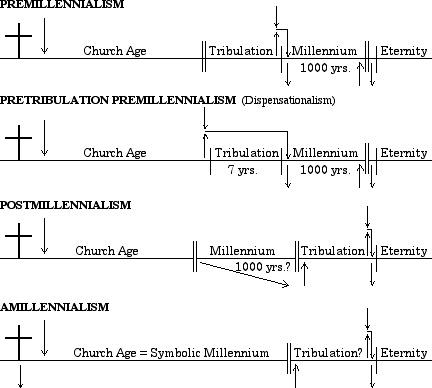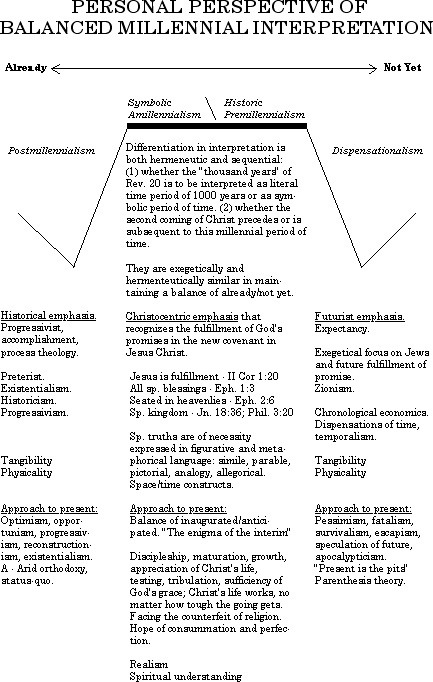©
1999 James A. Fowler
You are free to download
this outline provided it remains intact without alteration. You
are also free to transmit this outline electronically provided
that you do so in its entirety with proper citation of authorship
included.
MILLENNIUM
I. Biblical references
A. There are no usages of the word
"millennium" in the Bible.
B. "Millennium" is a theological
word derived from the Latin words mille, meaning "thousand,"
and
annus, meaning "year."
C. The theological word "millennium"
has been used to refer to the "thousand years"
mentioned
in Rev. 20:2-7.
Rev.
20:2 - "Devil and Satan, and bound him a thousand years"
Rev.
20:3 - "until the thousand years are fulfilled"
Rev.
20:4 - "they lived and reigned with Christ a thousand years"
Rev.
20:5 - "until the thousand years were ended"
Rev.
20:6 - "reign with Him a thousand years"
Rev.
20:7 - "whenever the thousand years are ended"
1. The Greek
words used in these verses
a.
chilia ete means "thousand years"
b.
Term "chiliasm" also sometimes used as theological
term for "thousand years," but often carries
pejorative sense.
2. There are
no other definite references to this period in the Bible.
3. Some theological
interpretations believe that other Biblical passages refer to
the period of the millennium.
O.T.
- Isa. 9:6; 11:1-12:6; 52:7-12; Jer. 33:17-22; Ezek. 37:25; Zech
9:9
N.T.
- Matt. 19:28; 25:31-46; Lk. 14:14; I Cor. 15:22; I Thess. 4:13-18
D. Other Biblical references to "thousand
years"
Ps.
90:4 - "a thousand years in Thy sight are like yesterday..."
II
Pet. 3:8 -"one day is as a thousand years, and a thousand
years as one day"
E. Primary questions to be considered
1. Is the number
of "a thousand" to be interpreted in a strict physical
and temporal sense, or
in
a symbolic, figurative manner (as almost all of the other numbers
in Revelation)?
2. Is the period
of time designated "a thousand years" in Rev. 20 to
be interpreted as prior to
or
subsequent to, the second advent of Jesus Christ?

II. Historical review of millennial thinking in Christian
theology.
A. Early church (c. 100-250) - millennium
not emphasized. Variety of views.
B. Early reaction to view of earthly
millennium.
1. Origen (c.
185-254) attributed such thinking to heretic, Cerinthus
2. Montanist
heresy (c.175) had excesses of earthly millennial views.
3. Rampant speculation
to calculate end time.
C. Augustine (354-430) rejected his previous
earthly millennial position and interpreted
"1000
years" of Rev. 20 as symbolic of entire period from first
coming of Christ to
second
coming of Christ.
1. Council of
Ephesus (431) condemned earthly millennium interpretation as
heretical
superstition.
2. Became orthodox
view of Church for centuries.
D. Reformation (sixteenth century) -
Luther, Calvin, Zwingli, Anabaptists accepted symbolic
interpretation
of "1000 years." Regarded Catholic Pope as Antichrist.
E. Seventeenth - nineteenth centuries
- gradually revived earthly millennium view.
F. Nineteenth & twentieth centuries.
1. J.N. Darby
(Plymouth Brethren), followed by D.L. Moody, C.I. Scofield, H.A.
Ironside
(Dallas
Theological Sem.), developed theological system of Dispensationalism
incorporating
earthly millennium and pre-tribulation rapture of Church. Became
a
primarily
American theological phenomenon.
2. Majority of
theological community (Post-millennial and Amillennial) has regarded
Dispensationalism
as a modernist aberrational interpretation.
III. Millennial interpretations

A. All interpretations
look forward to the "blessed hope and appearing of Jesus
Christ (Titus 2:13)
B. Most interpretations can trace
their roots to early Christian interpretation.
C. "...now I know in part;
then I shall fully understand" (I Cor. 13:12)
D. Must not make any interpretation
a test of faith or fellowship.
IV. Conclusion
A. Important to maintain Christocentric
emphasis.
B. New covenant teaching always maintains
balance between the "already" and the "not yet"
fulfilment
of the work of Jesus Christ.

|

















